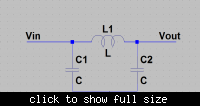iVenky
Advanced Member level 2
- Joined
- Jul 11, 2011
- Messages
- 584
- Helped
- 37
- Reputation
- 76
- Reaction score
- 35
- Trophy points
- 1,318
- Location
- College Station, Texas
- Activity points
- 6,124
Actually I got confused while deriving the frequency for colpitt's oscillator. The usual way of finding out the frequency is that I equate the imaginary part of the transfer function (of the feedback path) to zero and find out 'ω'. In colpitt's oscillator we have this circuit in the feedback path.

What is the transfer function of the above circuit. I tried it and I get a it to be indepedent of C1 itself!
V0/Vi= 1/(1+s²LC2)
and also there is no imaginary term at all!
Where's the mistake?
Thanks in advance.:?::?::?:

What is the transfer function of the above circuit. I tried it and I get a it to be indepedent of C1 itself!
V0/Vi= 1/(1+s²LC2)
and also there is no imaginary term at all!
Where's the mistake?
Thanks in advance.:?::?::?: